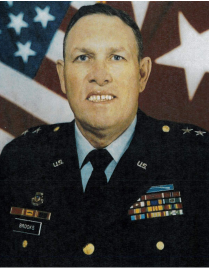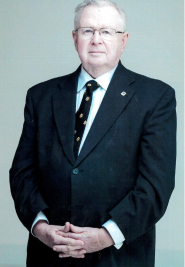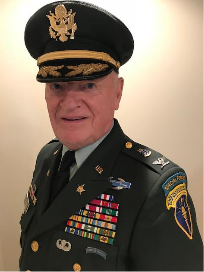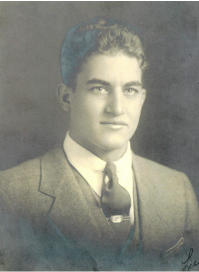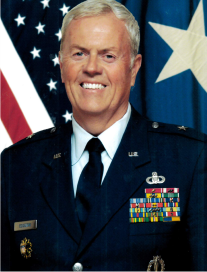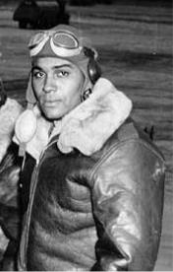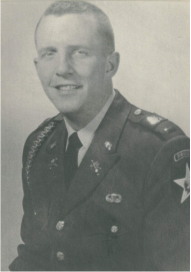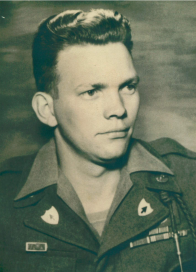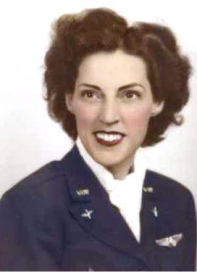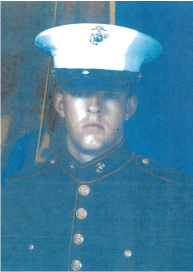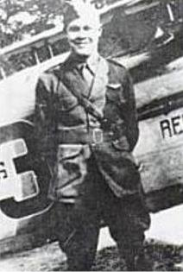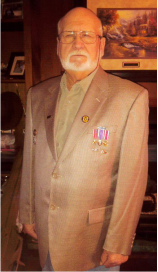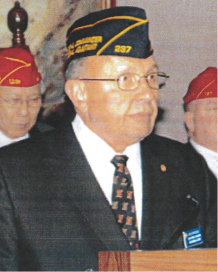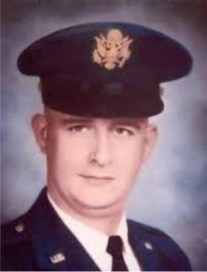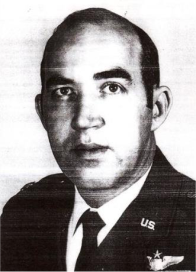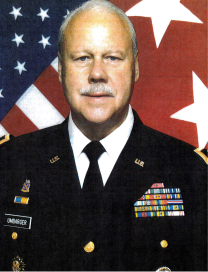Ronald Brooks
Major General Ronald E. Brooks spent 34 years in the Army, continuing to serve long after he retired in September of 1995. He served first as an Infantry Officer and followed as an Adjutant General Corps Officer. He completed his Army career as the Commanding General, U.S. Soldier Support Center, Fort Benjamin Harrison, Indiana.General Brooks led the transition for Fort Harrison from an active duty Army Post to a thriving civilian community. He is responsible for the smooth transition to the beautiful Fort Harrison State Park that exists to this very day. Under his leadership the Fort Harrison Golf Course became the Fort Harrison State Park Golf Course, the Officer’s Club became The Garrison Restaurant and golf pro-shop and the Fort Harrison Headquarters building became the Fort Harrison State Park Inn. General Brooks worked tirelessly to gain a Military Post Exchange and Commissary for the use of active duty, retired and reserve military personnel across the state of Indiana. What was once a building which housed military schools, now houses a Community College.General Brooks’ military awards and decorations include two Distinguished Service Medals, two Legion of Merits, three Bronze Stars, three Meritorious Service Medals, the Air Medal, three Army Commendation Medals and numerous unit, service and campaign medals as well as the Sagamore of the Wabash.
Major General Ronald E. Brooks spent 34 years in the Army, continuing to serve long after he retired in September of 1995. He served first as an Infantry Officer and followed as an Adjutant General Corps Officer. He completed his Army career as the Commanding General, U.S. Soldier Support Center, Fort Benjamin Harrison, Indiana.General Brooks led the transition for Fort Harrison from an active duty Army Post to a thriving civilian community. He is responsible for the smooth transition to the beautiful Fort Harrison State Park that exists to this very day. Under his leadership the Fort Harrison Golf Course became the Fort Harrison State Park Golf Course, the Officer’s Club became The Garrison Restaurant and golf pro-shop and the Fort Harrison Headquarters building became the Fort Harrison State Park Inn. General Brooks worked tirelessly to gain a Military Post Exchange and Commissary for the use of active duty, retired and reserve military personnel across the state of Indiana. What was once a building which housed military schools, now houses a Community College.General Brooks’ military awards and decorations include two Distinguished Service Medals, two Legion of Merits, three Bronze Stars, three Meritorious Service Medals, the Air Medal, three Army Commendation Medals and numerous unit, service and campaign medals as well as the Sagamore of the Wabash.
Joseph Bumbleburg
Lieutenant Colonel Joseph T. Bumbleburg graduated from the University of Notre Dame in 1958 and the I.U. School of Law in 1961. Following an active duty stint in the U.S. Army, Judge Advocate Generals Corps, Joe Bumbleburg has devoted his life to the service of others.Since serving on active duty, Joe Bumbleburg has served on the Board of Directors of the United Way of Lafayette as its President and as its 1st and 2nd Vice President. He has also served as a member of the Community Advisory Council, Purdue University School of Nursing and as a Trustee of the Lyn Treece Boys & Girls Club Foundation. Joe has participated as an officer in the Tippecanoe County, Indiana State and American Bar Association. He is a member of the American Judicature Society and The Judge Advocate Association, as well as a Master Life Fellow of the Indiana Bar Foundation.Upon his retirement from the United States Army Reserve, Lieutenant Colonel Bumbleburg was awarded the Meritorious Service Medal for his outstanding meritorious service as a Citizen Soldier.
Lieutenant Colonel Joseph T. Bumbleburg graduated from the University of Notre Dame in 1958 and the I.U. School of Law in 1961. Following an active duty stint in the U.S. Army, Judge Advocate Generals Corps, Joe Bumbleburg has devoted his life to the service of others.Since serving on active duty, Joe Bumbleburg has served on the Board of Directors of the United Way of Lafayette as its President and as its 1st and 2nd Vice President. He has also served as a member of the Community Advisory Council, Purdue University School of Nursing and as a Trustee of the Lyn Treece Boys & Girls Club Foundation. Joe has participated as an officer in the Tippecanoe County, Indiana State and American Bar Association. He is a member of the American Judicature Society and The Judge Advocate Association, as well as a Master Life Fellow of the Indiana Bar Foundation.Upon his retirement from the United States Army Reserve, Lieutenant Colonel Bumbleburg was awarded the Meritorious Service Medal for his outstanding meritorious service as a Citizen Soldier.
Robert Clifford
On May 16, 1967 First Lieutenant Robert A. Clifford was assigned the mission of lending assistance to a beleaguered patrol, to extract their casualties and maintain contact with the enemy force. Upon arrival at the conflict, he immediately evaluated the situation, maneuvered his platoon into position and brought fire on the enemy force in order to extract his wounded colleagues. He directed the fire of his platoon on the enemy and personally charged through the bullet swept area where wounded U.S. soldiers lay and personally carried them to safety.After all of the wounded were evacuated, First Lieutenant Clifford remained in the battle area to direct his men and maintain contact with the enemy. The actions of First Lieutenant Clifford resulted in saving the lives of numerous men and inspired the men of his platoon to successfully accomplish its mission.For his actions on that day First Lieutenant Clifford was awarded the Silver Star. In addition to the Silver Star, Colonel Clifford has also been awarded the Bronze Star (with Valor device), a second award of the Bronze Star, the Legion of Merit, the Meritorious Service Medal, the Army Commendation Medal, the Special Forces Tab and numerous campaign and service medals.
On May 16, 1967 First Lieutenant Robert A. Clifford was assigned the mission of lending assistance to a beleaguered patrol, to extract their casualties and maintain contact with the enemy force. Upon arrival at the conflict, he immediately evaluated the situation, maneuvered his platoon into position and brought fire on the enemy force in order to extract his wounded colleagues. He directed the fire of his platoon on the enemy and personally charged through the bullet swept area where wounded U.S. soldiers lay and personally carried them to safety.After all of the wounded were evacuated, First Lieutenant Clifford remained in the battle area to direct his men and maintain contact with the enemy. The actions of First Lieutenant Clifford resulted in saving the lives of numerous men and inspired the men of his platoon to successfully accomplish its mission.For his actions on that day First Lieutenant Clifford was awarded the Silver Star. In addition to the Silver Star, Colonel Clifford has also been awarded the Bronze Star (with Valor device), a second award of the Bronze Star, the Legion of Merit, the Meritorious Service Medal, the Army Commendation Medal, the Special Forces Tab and numerous campaign and service medals.
William Crouch
While at Purdue University Mr. Crouch joined the Reserve Officer Training Corps (ROTC) and upon graduation was commissioned as a Second Lieutenant in the U.S. Marine Corps. He served aboard U.S. Navy vessels and as a ground combat leader on Guadalcanal, the Solomon Islands and elsewhere in the Pacific Theater of World War II.For his extraordinary heroism on July 7, 1944 as Commanding Officer of the Third Battalion, Tenth Marines, Second Marine Division, on the island of Saipan, in the Marianas Islands, Major William L. Crouch was awarded the Navy Cross. In the face of overwhelming odds, Major Crouch led his men in the fight to retain their defensive positions. Recognizing the overpowering strength of the enemy forces he inspired his men to continue fighting while calling for reinforcements. Once those reinforcements arrived Major Crouch realigned his Marines and continued to carry the fight to the enemy and was able to regain some of the battle positions lost in the initial enemy engagement. He fearlessly braved a withering barrage of enemy fire to cross an open field in an effort to secure additional aid but was fatally struck down by hostile fire.In addition to the Navy Cross, Major Crouch was also awarded the Purple Heart and numerous service and achievement medals. Major Crouch is buried at Arlington National Cemetery.
While at Purdue University Mr. Crouch joined the Reserve Officer Training Corps (ROTC) and upon graduation was commissioned as a Second Lieutenant in the U.S. Marine Corps. He served aboard U.S. Navy vessels and as a ground combat leader on Guadalcanal, the Solomon Islands and elsewhere in the Pacific Theater of World War II.For his extraordinary heroism on July 7, 1944 as Commanding Officer of the Third Battalion, Tenth Marines, Second Marine Division, on the island of Saipan, in the Marianas Islands, Major William L. Crouch was awarded the Navy Cross. In the face of overwhelming odds, Major Crouch led his men in the fight to retain their defensive positions. Recognizing the overpowering strength of the enemy forces he inspired his men to continue fighting while calling for reinforcements. Once those reinforcements arrived Major Crouch realigned his Marines and continued to carry the fight to the enemy and was able to regain some of the battle positions lost in the initial enemy engagement. He fearlessly braved a withering barrage of enemy fire to cross an open field in an effort to secure additional aid but was fatally struck down by hostile fire.In addition to the Navy Cross, Major Crouch was also awarded the Purple Heart and numerous service and achievement medals. Major Crouch is buried at Arlington National Cemetery.
James Goodwin
Brigadier General Stewart attended the University of Evansville where he received a Bachelor’s Degree in Management and Marketing. While at the University he joined the Reserve Officer Training Corps (ROTC) and upon graduation was commissioned a Second Lieutenant in the U.S. Air Force. He served the next 37 years in all three components of the US Air Force: Active, Guard, and Reserve. Stew commanded an Intercontinental Ballistic Missile Combat Crew as the Launch Officer and simultaneously attended the University of Central Missouri to earn a Master’s Degree.He serves as the Executive Director of the Indiana War Memorials Commission and has served in that capacity under Governors Pence and Holcomb. As Director of Safety at Fort Benjamin Harrison, Stewart was responsible for the safety and occupational health of approximately 18,000 military and civilians employed on the installation.Brigadier General Goodwin established and organized the National Guard Association of Indiana Car-Bike-Truck Show to raise funds to support Hoosier Guardsmen and women and their families in order to defray college expenses. Over the years these shows raised over $180,000 and drew large crowds. In 2018 General Goodwin was the Master of Ceremonies for the Indy Honor Flight Homecoming.His awards include the 1973 Outstanding Young Men of America; the 2013 Dr. John Morton-Finney Leadership Award and the 2013 Sagamore of the Wabash. In addition, he has also been awarded the two Legion of Merits, three Meritorious Service Medal, four Air Force Commendation Medals, four Army Commendation Medals, the Air Force Achievement Medal and the Army Achievement Medal as well as numerous service and achievement medals.
Brigadier General Stewart attended the University of Evansville where he received a Bachelor’s Degree in Management and Marketing. While at the University he joined the Reserve Officer Training Corps (ROTC) and upon graduation was commissioned a Second Lieutenant in the U.S. Air Force. He served the next 37 years in all three components of the US Air Force: Active, Guard, and Reserve. Stew commanded an Intercontinental Ballistic Missile Combat Crew as the Launch Officer and simultaneously attended the University of Central Missouri to earn a Master’s Degree.He serves as the Executive Director of the Indiana War Memorials Commission and has served in that capacity under Governors Pence and Holcomb. As Director of Safety at Fort Benjamin Harrison, Stewart was responsible for the safety and occupational health of approximately 18,000 military and civilians employed on the installation.Brigadier General Goodwin established and organized the National Guard Association of Indiana Car-Bike-Truck Show to raise funds to support Hoosier Guardsmen and women and their families in order to defray college expenses. Over the years these shows raised over $180,000 and drew large crowds. In 2018 General Goodwin was the Master of Ceremonies for the Indy Honor Flight Homecoming.His awards include the 1973 Outstanding Young Men of America; the 2013 Dr. John Morton-Finney Leadership Award and the 2013 Sagamore of the Wabash. In addition, he has also been awarded the two Legion of Merits, three Meritorious Service Medal, four Air Force Commendation Medals, four Army Commendation Medals, the Air Force Achievement Medal and the Army Achievement Medal as well as numerous service and achievement medals.
Wilma Handshoe
Mrs. SuzAnne Handshoe, upon her separation from the United States Marine Corps, moved to Kendallville, Indiana and she still lives there today. In 2004 she became the first female Mayor of Kendallville and continues in that position. She is a graduate of the Indiana Purdue Fort Wayne campus with a Bachelor’s of Science Degree in Organizational Leadership.As a U.S. Marine Corps Warrant Officer 4, SuzAnne Handshoe served in Operation Desert Storm and was recalled to active duty service during Operation Enduring Freedom. Mayor Handshoe has served her state and community in uniform and as a civilian. She has been a member of American Legion Post 86, Kendallville, for over 20 years. She was the Coordinator for Noble County, Marine Corps Reserve Toys-for-Tots; was a member of the Committee on Veterans Affairs; and established the Veteran’s Memorial in Kendallville in 2018.As Mayor of Kendallville, SuzAnne Handshoe established the Mayor’s Youth Advocacy Council, is a member of the Life and Family Services Board of Directors and the Kendallville Public Library Word-Up Initiative.Among her awards are the Channel 21 New Women in Leadership Honor. She was her party’s Noble County Distinguished Service Award recipient and was named Sagamore of the Wabash by Governor Mike Pence in 2016.
Mrs. SuzAnne Handshoe, upon her separation from the United States Marine Corps, moved to Kendallville, Indiana and she still lives there today. In 2004 she became the first female Mayor of Kendallville and continues in that position. She is a graduate of the Indiana Purdue Fort Wayne campus with a Bachelor’s of Science Degree in Organizational Leadership.As a U.S. Marine Corps Warrant Officer 4, SuzAnne Handshoe served in Operation Desert Storm and was recalled to active duty service during Operation Enduring Freedom. Mayor Handshoe has served her state and community in uniform and as a civilian. She has been a member of American Legion Post 86, Kendallville, for over 20 years. She was the Coordinator for Noble County, Marine Corps Reserve Toys-for-Tots; was a member of the Committee on Veterans Affairs; and established the Veteran’s Memorial in Kendallville in 2018.As Mayor of Kendallville, SuzAnne Handshoe established the Mayor’s Youth Advocacy Council, is a member of the Life and Family Services Board of Directors and the Kendallville Public Library Word-Up Initiative.Among her awards are the Channel 21 New Women in Leadership Honor. She was her party’s Noble County Distinguished Service Award recipient and was named Sagamore of the Wabash by Governor Mike Pence in 2016.
Michael Huggins
PFC Michael Allen Huggins arrived in Vietnam in 1969 and was assigned to the Third Platoon, Company G, Second Battalion, Fourth Marines, Third Marine Division.Commanding a fire team, of his company, Private First Class Huggins was in combat operations against the enemy near Quang Tri province and was maneuvering his fire team into position when he noticed an enemy squad setting up an ambush position. He immediately and skillfully deployed his fire team and initiated contact with the enemy squad. Although painfully wounded in his abdomen, he did not hesitate in leading his men courageously throughout the fire-swept terrain, shouting instructions and encouraging his men as he directed their fire on the enemy. When a hostile grenade landed near him, Private First Class Huggins immediately picked up the grenade and threw it back at the enemy where it subsequently exploded. Relentlessly pursuing his objective, he continued his assault against the hostile bunkers, forcing the enemy to break contact and retreat. His heroic and timely actions inspired all who observed him and contributed significantly to the defeat of the enemy force. For his actions on that day, 27 June 1969, Private First Class Michael A. Huggins was awarded the Navy Cross.In addition to the Navy Cross, Private First Class Huggins was also awarded the Purple Heart Medal and numerous campaign and service medals.
PFC Michael Allen Huggins arrived in Vietnam in 1969 and was assigned to the Third Platoon, Company G, Second Battalion, Fourth Marines, Third Marine Division.Commanding a fire team, of his company, Private First Class Huggins was in combat operations against the enemy near Quang Tri province and was maneuvering his fire team into position when he noticed an enemy squad setting up an ambush position. He immediately and skillfully deployed his fire team and initiated contact with the enemy squad. Although painfully wounded in his abdomen, he did not hesitate in leading his men courageously throughout the fire-swept terrain, shouting instructions and encouraging his men as he directed their fire on the enemy. When a hostile grenade landed near him, Private First Class Huggins immediately picked up the grenade and threw it back at the enemy where it subsequently exploded. Relentlessly pursuing his objective, he continued his assault against the hostile bunkers, forcing the enemy to break contact and retreat. His heroic and timely actions inspired all who observed him and contributed significantly to the defeat of the enemy force. For his actions on that day, 27 June 1969, Private First Class Michael A. Huggins was awarded the Navy Cross.In addition to the Navy Cross, Private First Class Huggins was also awarded the Purple Heart Medal and numerous campaign and service medals.
Armour McDaniel
Lieutenant Colonel Armour G. McDaniel graduated from Virginia State University, with a Bachelor of Science Degree in Business Administration. He was teaching High School English when World War II broke out and joined the military being initially stationed at Tuskegee Army Air Field as a cadet. In 1944 he was transferred to Taranto, Italy. In January 1945, he became the Commander of the 301st Fighter Squadron which flew the infamous red tailed P-51 Mustang. The Squadron’s mission was to escort bombers on their flights into enemy territory. During one of these missions, Lieutenant Colonel McDaniel was forced to land as a result of engine failure. Both of his legs were broken in the landing and he was taken prisoner by the German Army to Nuremburg and then to Moosburg, Stalag Luf 7A. He amassed over 9,000 hours of flying time during World War II, in nineteen different aircraft, and is credited with shooting down one German BF-109, destroying 109 ground vehicles, three planes on the ground as well as a number of German tanks.Lieutenant Colonel McDaniel retired from the Air Force in 1964 and continued to serve as the Executive Director – Interracial Council of Business Opportunity, the Director of Small Business Development Center and Supervisor Bureau of Management Services, Department of Education, New Jersey. Additionally, he was a founding member and 1st President of the Indianapolis Chapter, Tuskegee Airmen.Lieutenant Colonel McDaniel’s military awards include the Distinguished Flying Cross, the Purple Heart Medal, five Air Medals, the Air Force Commendation Medal, and numerous campaign and service medals.
Lieutenant Colonel Armour G. McDaniel graduated from Virginia State University, with a Bachelor of Science Degree in Business Administration. He was teaching High School English when World War II broke out and joined the military being initially stationed at Tuskegee Army Air Field as a cadet. In 1944 he was transferred to Taranto, Italy. In January 1945, he became the Commander of the 301st Fighter Squadron which flew the infamous red tailed P-51 Mustang. The Squadron’s mission was to escort bombers on their flights into enemy territory. During one of these missions, Lieutenant Colonel McDaniel was forced to land as a result of engine failure. Both of his legs were broken in the landing and he was taken prisoner by the German Army to Nuremburg and then to Moosburg, Stalag Luf 7A. He amassed over 9,000 hours of flying time during World War II, in nineteen different aircraft, and is credited with shooting down one German BF-109, destroying 109 ground vehicles, three planes on the ground as well as a number of German tanks.Lieutenant Colonel McDaniel retired from the Air Force in 1964 and continued to serve as the Executive Director – Interracial Council of Business Opportunity, the Director of Small Business Development Center and Supervisor Bureau of Management Services, Department of Education, New Jersey. Additionally, he was a founding member and 1st President of the Indianapolis Chapter, Tuskegee Airmen.Lieutenant Colonel McDaniel’s military awards include the Distinguished Flying Cross, the Purple Heart Medal, five Air Medals, the Air Force Commendation Medal, and numerous campaign and service medals.
Thomas Metsker
Captain Thomas C. Metsker reported for duty in the Republic of Vietnam, in August 1965. Upon his arrival he was assigned as the Intelligence Officer for the First Battalion, 7th Cavalry Division, then commanded by Colonel Hall Moore, that would become famous at the battle of the Ia Drang Valley in the book and movie “We Were Soldiers.” On 14 November 1965, 400 American soldiers from Captain Metsker’s unit marched into the Ia Drang Valley and were met by over 4,000 enemy soldiers of North Vietnam. During the ensuing battle, 130 American soldiers were wounded and 72 were killed in action, including Captain Metsker.Captain Metsker was wounded in the shoulder while firing his rifle at the enemy and was moved to a medical evacuation site. Captain Metsker was being loaded onto a medical evacuation helicopter when another soldier arrived at the site and who appeared to be more seriously wounded then Captain Metsker. Thomas Metsker gave up his place on the evacuation helicopter so the other soldier could be evacuated and treated for his wounds. Captain Metsker was helping load his fellow combatant onto the helicopter when a sniper fired and hit Captain Metsker. The round struck Captain Metsker in the back and he fell forward onto the floor of the helicopter. The helicopter was able to take off and land safely at the medical treatment site; however, upon landing the crew discovered that Captain Metsker was no longer among the living.For his actions that day Captain Thomas C. Metsker was awarded the Bronze Star Medal (with “Valor” Device). Additionally, Captain Metsker’s awards and decorations include a second award of the Bronze Star Medal, the Purple Heart Medal and numerous service and campaign medals.
Captain Thomas C. Metsker reported for duty in the Republic of Vietnam, in August 1965. Upon his arrival he was assigned as the Intelligence Officer for the First Battalion, 7th Cavalry Division, then commanded by Colonel Hall Moore, that would become famous at the battle of the Ia Drang Valley in the book and movie “We Were Soldiers.” On 14 November 1965, 400 American soldiers from Captain Metsker’s unit marched into the Ia Drang Valley and were met by over 4,000 enemy soldiers of North Vietnam. During the ensuing battle, 130 American soldiers were wounded and 72 were killed in action, including Captain Metsker.Captain Metsker was wounded in the shoulder while firing his rifle at the enemy and was moved to a medical evacuation site. Captain Metsker was being loaded onto a medical evacuation helicopter when another soldier arrived at the site and who appeared to be more seriously wounded then Captain Metsker. Thomas Metsker gave up his place on the evacuation helicopter so the other soldier could be evacuated and treated for his wounds. Captain Metsker was helping load his fellow combatant onto the helicopter when a sniper fired and hit Captain Metsker. The round struck Captain Metsker in the back and he fell forward onto the floor of the helicopter. The helicopter was able to take off and land safely at the medical treatment site; however, upon landing the crew discovered that Captain Metsker was no longer among the living.For his actions that day Captain Thomas C. Metsker was awarded the Bronze Star Medal (with “Valor” Device). Additionally, Captain Metsker’s awards and decorations include a second award of the Bronze Star Medal, the Purple Heart Medal and numerous service and campaign medals.
Chester Miller
Private First Class Chester R. Miller, while assigned to Company A, 26th Infantry, 1st Infantry Division on2 February 1945, in the vicinity of Hollerath, Germany encountered his company’s position being subjected to heavy enemy artillery fire, mortar and automatic weapons fire resulting in many casualties. Private Miller courageously crossed perilous terrain to aid his wounded comrades. Upon reaching the injured, and with utter disregard for his own personal safety, skillfully administered first aid and evacuated the injured soldiers to a place of safety. Private First Class Miller’s gallant actions and unswerving devotion to duty exemplify the indomitable loyalty of the American soldier.For his actions on that day Private First Class Miller was awarded the Silver Star Medal. Private First Class Miller’s awards and decorations also include the Bronze Star Medal, the Purple Heart Medal in addition to service and campaign medals.Chester Miller was also awarded a Certificate of Recognition signed by General Jimmy Doolittle and General William Westmoreland. In that certificate, the Generals noted that the world survived World War II and democracy lives on because of the heroic deeds and hardships endured by patriotic veterans such as Private First Class Chester R. Miller.
Private First Class Chester R. Miller, while assigned to Company A, 26th Infantry, 1st Infantry Division on2 February 1945, in the vicinity of Hollerath, Germany encountered his company’s position being subjected to heavy enemy artillery fire, mortar and automatic weapons fire resulting in many casualties. Private Miller courageously crossed perilous terrain to aid his wounded comrades. Upon reaching the injured, and with utter disregard for his own personal safety, skillfully administered first aid and evacuated the injured soldiers to a place of safety. Private First Class Miller’s gallant actions and unswerving devotion to duty exemplify the indomitable loyalty of the American soldier.For his actions on that day Private First Class Miller was awarded the Silver Star Medal. Private First Class Miller’s awards and decorations also include the Bronze Star Medal, the Purple Heart Medal in addition to service and campaign medals.Chester Miller was also awarded a Certificate of Recognition signed by General Jimmy Doolittle and General William Westmoreland. In that certificate, the Generals noted that the world survived World War II and democracy lives on because of the heroic deeds and hardships endured by patriotic veterans such as Private First Class Chester R. Miller.
Turner Nolan
Colonel Nolan Turner served on active duty and in the Army National Guard from his enlistment as a Private until his retirement in the rank of Colonel. He has been an active member of the American Legion Post 18 for more than 50 years and in 2018 he was selected as “Legionnaire of the Year.” He has held many offices in his American Legion Post. He provided assistance to veterans in making application for disability benefits and appeared with the veterans before judges. Following up after applications had been filed with the Veterans Administration, he would meet as needed and devote his time to ensure applications were moving within the Veterans Administration system. Turner Nolan served as an assistance person for survivors of military veterans of all branches of the military.In 1988 he was awarded the Sagamore of the Wabash by Governor Robert Orr and in 1989 the Governor of Kentucky, Wallace Wilkinson, named Turner Nolan a Kentucky Colonel due to his volunteer participation in philanthropic activities.Colonel Nolan’s military awards and decorations include the Legion of Merit, Meritorious Service Medal, Army Commendation Medal, Army Achievement Medal and numerous campaign and service medals.
Colonel Nolan Turner served on active duty and in the Army National Guard from his enlistment as a Private until his retirement in the rank of Colonel. He has been an active member of the American Legion Post 18 for more than 50 years and in 2018 he was selected as “Legionnaire of the Year.” He has held many offices in his American Legion Post. He provided assistance to veterans in making application for disability benefits and appeared with the veterans before judges. Following up after applications had been filed with the Veterans Administration, he would meet as needed and devote his time to ensure applications were moving within the Veterans Administration system. Turner Nolan served as an assistance person for survivors of military veterans of all branches of the military.In 1988 he was awarded the Sagamore of the Wabash by Governor Robert Orr and in 1989 the Governor of Kentucky, Wallace Wilkinson, named Turner Nolan a Kentucky Colonel due to his volunteer participation in philanthropic activities.Colonel Nolan’s military awards and decorations include the Legion of Merit, Meritorious Service Medal, Army Commendation Medal, Army Achievement Medal and numerous campaign and service medals.
Jeanne Norbeck
Jeanne Lewellen Norbeck moved with her husband to Oahu, Territory of Hawaii, in 1940. She and her husband lived in a hotel in Honolulu and witnessed the bombing of Pearl Harbor on December 7, 1941. Due to travel restrictions she was not allowed to leave Hawaii and served as an air raid warden. Flying was her first love and she had begun taking pilot lessons while in high school. After returning to the United States she learned of a need for female pilots and without hesitation applied for the Women’s Airforce Service Pilots (WASP).Jeanne was accepted into the program and upon graduation from a training class she was named one of a few women to test air planes that the Army Air Force was having difficulty with in identifying hidden problems. On 7 October 1944, while testing a BT-13 bomber, with dangerous stall characteristics, the aircraft spun from a low altitude, crashed, and burned. Jeanne Lewellen Norbeck became one of 38 WASPs killed in the line of duty.Members of her command, under the leadership of Lieutenant Colonel T. F. Osborne, paid for the return of her body to Columbus, IN and were there to perform a full military burial. She was the only “civilian” woman in World War II to have a military funeral. It was not until Senator Barry Goldwater, in 1977, championed a bill through Congress recognizing the WASPs as veterans of the military.
Jeanne Lewellen Norbeck moved with her husband to Oahu, Territory of Hawaii, in 1940. She and her husband lived in a hotel in Honolulu and witnessed the bombing of Pearl Harbor on December 7, 1941. Due to travel restrictions she was not allowed to leave Hawaii and served as an air raid warden. Flying was her first love and she had begun taking pilot lessons while in high school. After returning to the United States she learned of a need for female pilots and without hesitation applied for the Women’s Airforce Service Pilots (WASP).Jeanne was accepted into the program and upon graduation from a training class she was named one of a few women to test air planes that the Army Air Force was having difficulty with in identifying hidden problems. On 7 October 1944, while testing a BT-13 bomber, with dangerous stall characteristics, the aircraft spun from a low altitude, crashed, and burned. Jeanne Lewellen Norbeck became one of 38 WASPs killed in the line of duty.Members of her command, under the leadership of Lieutenant Colonel T. F. Osborne, paid for the return of her body to Columbus, IN and were there to perform a full military burial. She was the only “civilian” woman in World War II to have a military funeral. It was not until Senator Barry Goldwater, in 1977, championed a bill through Congress recognizing the WASPs as veterans of the military.
Ernest Pyle
Ernest Taylor Pyle, upon graduation from high school, enlisted in the Naval Reserves and was honorably discharged in the rank of Seaman 3rd Class. He attended Indiana University and edited the Indiana Daily Student leaving the University with only one semester left to finish his degree and accepted a job at a newspaper in LaPorte, Indiana. He later moved to Washington D.C. where he served as a reporter for The Washington Daily News. In 1932 he was named Managing Editor and served in that post for three years.When the U.S. entered World War II on 8 December 1941 Ernie Pyle became a war correspondent, generally writing from the perspective of the common soldier. Reinforcing his status as the “dogface’s” best friend, Pyle wrote an article in 1944 urging that soldiers in combat get “fight pay” just as airmen were paid “flight pay.” Following his article, Congress passed a law authorizing $10 per month extra pay for combat infantrymen. That legislation was called “the Ernie Pyle bill.” After the war in Europe ended, Ernie Pyle joined the war in the Pacific. On 17 April 1945, Pyle came ashore with the Army’s 305th Infantry Regiment, 77th Infantry Division on the island of Ie Shima, a small island northwest of Okinawa. The following day, Mr. Pyle was riding in a jeep with the commanding officer of the 305th, when the jeep encountered enemy machine gun fire. When an enemy round struck Mr. Pyle he was killed instantly.In addition to numerous news reporting and civic support awards, and by a special act of Congress and for his dedicated support to our nation, Ernie Pyle was awarded the Purple Heart MedalMr. Ernest Taylor Pyle is buried in the Punch Bowl Memorial Cemetery in Honolulu, Hawaii.
Ernest Taylor Pyle, upon graduation from high school, enlisted in the Naval Reserves and was honorably discharged in the rank of Seaman 3rd Class. He attended Indiana University and edited the Indiana Daily Student leaving the University with only one semester left to finish his degree and accepted a job at a newspaper in LaPorte, Indiana. He later moved to Washington D.C. where he served as a reporter for The Washington Daily News. In 1932 he was named Managing Editor and served in that post for three years.When the U.S. entered World War II on 8 December 1941 Ernie Pyle became a war correspondent, generally writing from the perspective of the common soldier. Reinforcing his status as the “dogface’s” best friend, Pyle wrote an article in 1944 urging that soldiers in combat get “fight pay” just as airmen were paid “flight pay.” Following his article, Congress passed a law authorizing $10 per month extra pay for combat infantrymen. That legislation was called “the Ernie Pyle bill.” After the war in Europe ended, Ernie Pyle joined the war in the Pacific. On 17 April 1945, Pyle came ashore with the Army’s 305th Infantry Regiment, 77th Infantry Division on the island of Ie Shima, a small island northwest of Okinawa. The following day, Mr. Pyle was riding in a jeep with the commanding officer of the 305th, when the jeep encountered enemy machine gun fire. When an enemy round struck Mr. Pyle he was killed instantly.In addition to numerous news reporting and civic support awards, and by a special act of Congress and for his dedicated support to our nation, Ernie Pyle was awarded the Purple Heart MedalMr. Ernest Taylor Pyle is buried in the Punch Bowl Memorial Cemetery in Honolulu, Hawaii.
John Rankel
Sergeant John Rankel, following graduation from high school and then from boot camp, reported to the USMC School of Infantry. He graduated with honors and was deployed to Iraq in 2007. After returning John reenlisted and was promoted to Sergeant. The Marine Corps rewarded him as a rifle squad leader, his original goal upon entering the Marine Corps.On 6 and 7 June 2010, in support of Operation Enduring Freedom, Sergeant Rankel’s unit came under fire from a platoon sized ambush, reinforced with machine guns. With half of his squad pinned down in the enemy’s main engagement area, he boldly led the remainder of his squad forward across more than 600 meters of open terrain to reinforce the Marines in contact. Despite the desperate situation, he mounted a successful defense with a counter attack. His bold and timely action facilitated a rapid reinforcement of the Marines and prevented the enemy from overwhelming the pinned down squad members. As his Marines ran low on ammunition, he prepared to lead a direct assault on the enemy position, however, he was ordered to retreat. He ordered his men to withdraw while he covered their withdrawal with small arms fire. When the squad had returned to safety he began his movement to the rear. As he returned to the new position he was mortally wounded.By his extraordinary guidance and zealous initiative on that day Sergeant Rankel was posthumously awarded the Bronze Star with a V device for valor and the Purple Heart.
Sergeant John Rankel, following graduation from high school and then from boot camp, reported to the USMC School of Infantry. He graduated with honors and was deployed to Iraq in 2007. After returning John reenlisted and was promoted to Sergeant. The Marine Corps rewarded him as a rifle squad leader, his original goal upon entering the Marine Corps.On 6 and 7 June 2010, in support of Operation Enduring Freedom, Sergeant Rankel’s unit came under fire from a platoon sized ambush, reinforced with machine guns. With half of his squad pinned down in the enemy’s main engagement area, he boldly led the remainder of his squad forward across more than 600 meters of open terrain to reinforce the Marines in contact. Despite the desperate situation, he mounted a successful defense with a counter attack. His bold and timely action facilitated a rapid reinforcement of the Marines and prevented the enemy from overwhelming the pinned down squad members. As his Marines ran low on ammunition, he prepared to lead a direct assault on the enemy position, however, he was ordered to retreat. He ordered his men to withdraw while he covered their withdrawal with small arms fire. When the squad had returned to safety he began his movement to the rear. As he returned to the new position he was mortally wounded.By his extraordinary guidance and zealous initiative on that day Sergeant Rankel was posthumously awarded the Bronze Star with a V device for valor and the Purple Heart.
Karl Schoen
First Lieutenant Karl John Schoen enlisted in the Army shortly after the United States entered World War I and volunteered for flight training in Texas. Upon graduation from flight school, he was stationed in France as a member of the 136th Aero Squadron where he became one of the United States’ first aces.The mystique of the fighter pilot was in its infancy in 1918 and the newspaper articles in his hometown brought the news of his exploits back home as he became an Ace. Those same newspapers shared the stories of him shooting down his 7th enemy fighter, and on 29 October 1918, they published a story of his tragic death, just 13 days before the end of WW I.For his actions on 10 October 1918 First Lieutenant Schoen was awarded the Distinguished Service Cross. The citation reads as follows: The President of the United States of America, takes pride in presenting the Distinguished Service Cross (Posthumously) to First Lieutenant Karl John Schoen, United States Army Air Service, for extraordinary heroism in action near Ancerville, France. While leading a patrol of three aircraft, he sighted nine enemy aircraft and immediately attacked them. He destroyed one aircraft and put the others to flight. He was killed in action on 29 October 1918 being officially credited with destroying seven enemy aircraft.
First Lieutenant Karl John Schoen enlisted in the Army shortly after the United States entered World War I and volunteered for flight training in Texas. Upon graduation from flight school, he was stationed in France as a member of the 136th Aero Squadron where he became one of the United States’ first aces.The mystique of the fighter pilot was in its infancy in 1918 and the newspaper articles in his hometown brought the news of his exploits back home as he became an Ace. Those same newspapers shared the stories of him shooting down his 7th enemy fighter, and on 29 October 1918, they published a story of his tragic death, just 13 days before the end of WW I.For his actions on 10 October 1918 First Lieutenant Schoen was awarded the Distinguished Service Cross. The citation reads as follows: The President of the United States of America, takes pride in presenting the Distinguished Service Cross (Posthumously) to First Lieutenant Karl John Schoen, United States Army Air Service, for extraordinary heroism in action near Ancerville, France. While leading a patrol of three aircraft, he sighted nine enemy aircraft and immediately attacked them. He destroyed one aircraft and put the others to flight. He was killed in action on 29 October 1918 being officially credited with destroying seven enemy aircraft.
Charles V Smith Jr.
Sergeant Major Charles V. Smith, Jr. was trained as an Infantryman at Fort Benning, Georgia and receive additional training in the Army as a Cavalry Scout and as a Unit Supply Specialist.As a Staff Sergeant, Charles Smith was assigned to the 4th Battalion, 503rd (Airborne) in the Republic of Vietnam. While on an operation Staff Sergeant Smith’s unit came under increasing fire from a well-fortified enemy position until the entire company was pinned down. As the ensuing fire fight developed, the platoon leader became an immediate casualty. As “acting platoon sergeant” Staff Sergeant Smith immediately began to move to a position where he could assume command of the company. Without hesitation he exposed himself to enemy fire becoming seriously wounded. Staff Sergeant Smith remained in his position and shouted directions and encouragement to his platoon. Staff Sergeant Smith’s outstanding display of aggressiveness, devotion to duty and personal bravery were in keeping with the highest traditions of the military.For his actions that day Staff Sergeant Charles Smith was awarded the Bronze Star Medal with a V device for valor. Command Sergeant Major Smith’s awards and decorations also include two additional Bronze Stars for meritorious service, the Purple Heart Medal, two Army Commendation Medals, the Combat Infantryman’s Badge and numerous campaign and service medals.
Sergeant Major Charles V. Smith, Jr. was trained as an Infantryman at Fort Benning, Georgia and receive additional training in the Army as a Cavalry Scout and as a Unit Supply Specialist.As a Staff Sergeant, Charles Smith was assigned to the 4th Battalion, 503rd (Airborne) in the Republic of Vietnam. While on an operation Staff Sergeant Smith’s unit came under increasing fire from a well-fortified enemy position until the entire company was pinned down. As the ensuing fire fight developed, the platoon leader became an immediate casualty. As “acting platoon sergeant” Staff Sergeant Smith immediately began to move to a position where he could assume command of the company. Without hesitation he exposed himself to enemy fire becoming seriously wounded. Staff Sergeant Smith remained in his position and shouted directions and encouragement to his platoon. Staff Sergeant Smith’s outstanding display of aggressiveness, devotion to duty and personal bravery were in keeping with the highest traditions of the military.For his actions that day Staff Sergeant Charles Smith was awarded the Bronze Star Medal with a V device for valor. Command Sergeant Major Smith’s awards and decorations also include two additional Bronze Stars for meritorious service, the Purple Heart Medal, two Army Commendation Medals, the Combat Infantryman’s Badge and numerous campaign and service medals.
Robert Spanogle
Robert W. Spanogle enlisted in the Army as an Artilleryman in 1962, served in Germany and was honorably discharged in 1965. After joining a local American Legion Post in Lansing, Michigan, he began a lifelong career of helping veterans. At the national level he has served as the National Commander of the American Legion and for 26 years as the National Adjutant. Bob Spanogle also served as the Executive Director of the American Legion’s Washington, D.C. Headquarters and as Director of Internal Affairs at the Legion’s National Headquarters in Indianapolis. In 1985 he was named an Honorary Past Department Commander of the American Legion of Michigan.While a student at Michigan State University, he was elected President of the National Association of Collegiate Veterans and in 1971 he served as consultant to veterans’ outreach programs for the National League of Cities and the United States Conference of Mayors. Since 2003 Bob has served as the Civilian Aide to the Secretary of the Army for the State of Indiana.Bob Spanogle is a Past President and member of the Board of Directors of the Veterans Day Council of Indianapolis and served on the President’s Commission on Veterans and Military Health Care. He is a past Secretary of the Board of Directors of the 500 Festival Associates and served on the Board of Crossroads Council, Boy Scouts of America. He has been recognized with the Gold Good Citizenship Medal from the National Society of the Sons of the American Revolution and is the recipient of the Distinguished Service Medal for Outstanding Service from Governor Mitch Daniels. Governor Daniels named Bob Spanogle a Distinguished Hoosier and presented him the Sagamore of the Wabash Award.
Robert W. Spanogle enlisted in the Army as an Artilleryman in 1962, served in Germany and was honorably discharged in 1965. After joining a local American Legion Post in Lansing, Michigan, he began a lifelong career of helping veterans. At the national level he has served as the National Commander of the American Legion and for 26 years as the National Adjutant. Bob Spanogle also served as the Executive Director of the American Legion’s Washington, D.C. Headquarters and as Director of Internal Affairs at the Legion’s National Headquarters in Indianapolis. In 1985 he was named an Honorary Past Department Commander of the American Legion of Michigan.While a student at Michigan State University, he was elected President of the National Association of Collegiate Veterans and in 1971 he served as consultant to veterans’ outreach programs for the National League of Cities and the United States Conference of Mayors. Since 2003 Bob has served as the Civilian Aide to the Secretary of the Army for the State of Indiana.Bob Spanogle is a Past President and member of the Board of Directors of the Veterans Day Council of Indianapolis and served on the President’s Commission on Veterans and Military Health Care. He is a past Secretary of the Board of Directors of the 500 Festival Associates and served on the Board of Crossroads Council, Boy Scouts of America. He has been recognized with the Gold Good Citizenship Medal from the National Society of the Sons of the American Revolution and is the recipient of the Distinguished Service Medal for Outstanding Service from Governor Mitch Daniels. Governor Daniels named Bob Spanogle a Distinguished Hoosier and presented him the Sagamore of the Wabash Award.
Kenneth Stonebraker
Lieutenant Colonel Kenneth A. Stonebraker joined the Air Force on 5 November 1958 and reported to duty at Lackland AFB, Texas. He graduated from pilot training on 21 October 1959 and following flight school Lieutenant Colonel Stonebraker had numerous assignments across the United States.Then as Captain Stonebraker, he was assigned to the 7th Air Force, 432nd Tactical Reconnaissance Wing, Udorn Airfield, Thailand. In the pre-dawn hours of October 28, 1968 Captain Stonebraker was the Navigator in an RF-4C on a single aircraft photo reconnaissance mission over the Quang Khe Ferry near the port city of Dong Hoi, North Vietnam. Once the mission was completed Captain Stonebraker received egress instructions from Airborne Command and Control to return to Udorn Airfield. During Captain Stonebraker’s return to Thailand Airborne Command and Control lost radar and voice contact with Captain Stonebraker’s aircraft. All attempts by search and rescue to locate the downed plane failed and Captain Stonebraker was listed as Missing-In-Action (MIA).His remains have never been recovered and he remains one of more than 1,600 POWs/MIAs still not yet returned to the U.S. A memorial to Kenneth Stonebraker has been erected at Arlington National Cemetery in Washington D.C.Lieutenant Colonel Stonebraker’s awards and decorations include the Distinguished Flying Cross, the Purple Heart, the Air Medal and numerous service campaign medals and awards.
Lieutenant Colonel Kenneth A. Stonebraker joined the Air Force on 5 November 1958 and reported to duty at Lackland AFB, Texas. He graduated from pilot training on 21 October 1959 and following flight school Lieutenant Colonel Stonebraker had numerous assignments across the United States.Then as Captain Stonebraker, he was assigned to the 7th Air Force, 432nd Tactical Reconnaissance Wing, Udorn Airfield, Thailand. In the pre-dawn hours of October 28, 1968 Captain Stonebraker was the Navigator in an RF-4C on a single aircraft photo reconnaissance mission over the Quang Khe Ferry near the port city of Dong Hoi, North Vietnam. Once the mission was completed Captain Stonebraker received egress instructions from Airborne Command and Control to return to Udorn Airfield. During Captain Stonebraker’s return to Thailand Airborne Command and Control lost radar and voice contact with Captain Stonebraker’s aircraft. All attempts by search and rescue to locate the downed plane failed and Captain Stonebraker was listed as Missing-In-Action (MIA).His remains have never been recovered and he remains one of more than 1,600 POWs/MIAs still not yet returned to the U.S. A memorial to Kenneth Stonebraker has been erected at Arlington National Cemetery in Washington D.C.Lieutenant Colonel Stonebraker’s awards and decorations include the Distinguished Flying Cross, the Purple Heart, the Air Medal and numerous service campaign medals and awards.
John Stuart
Lieutenant Colonel John Franklin Stuart attended Purdue University before joining the U.S. Air Force to attend Officer Candidate School and flight training. Following flight school, he was assigned as the co-pilot of a B-47, followed by assignment as a B-52 co-pilot, then as a combat aircraft commander and eventually as a B-52 command pilot assigned to the 307th Strategic Wing, Utopea AB Thailand. On 20 December 1972, while participating in Operation Linebacker II as a B-52D Aircraft Commander, then Major Stuart was flying a high-priority bombing mission against vital military targets over Hanoi, North Vietnam. Despite the intensity of defensive reaction and the extreme hazards posed by numerous surface-to-air missiles and hostile interceptors, Major Stuart displayed a courageous willingness to place the mission above his personal safety in directing his aircraft to a successful release of its ordinance on the designated target. On the egress from the target Major Stuart’s B-52 was shot down by a surface-to-air missile.For his actions that day Major Stuart was awarded the Distinguished Flying Cross (with Valor device). Lieutenant Colonel Stuart’s awards and decoration also include the Purple Heart Medal, fourteen Air Medals and numerous campaign and service medals.Lieutenant Colonel Stuart’s remains have never been recovered and he remains one of more than 1,600 POWs/MIAs still not returned to the United States.
Lieutenant Colonel John Franklin Stuart attended Purdue University before joining the U.S. Air Force to attend Officer Candidate School and flight training. Following flight school, he was assigned as the co-pilot of a B-47, followed by assignment as a B-52 co-pilot, then as a combat aircraft commander and eventually as a B-52 command pilot assigned to the 307th Strategic Wing, Utopea AB Thailand. On 20 December 1972, while participating in Operation Linebacker II as a B-52D Aircraft Commander, then Major Stuart was flying a high-priority bombing mission against vital military targets over Hanoi, North Vietnam. Despite the intensity of defensive reaction and the extreme hazards posed by numerous surface-to-air missiles and hostile interceptors, Major Stuart displayed a courageous willingness to place the mission above his personal safety in directing his aircraft to a successful release of its ordinance on the designated target. On the egress from the target Major Stuart’s B-52 was shot down by a surface-to-air missile.For his actions that day Major Stuart was awarded the Distinguished Flying Cross (with Valor device). Lieutenant Colonel Stuart’s awards and decoration also include the Purple Heart Medal, fourteen Air Medals and numerous campaign and service medals.Lieutenant Colonel Stuart’s remains have never been recovered and he remains one of more than 1,600 POWs/MIAs still not returned to the United States.
Roy Umbarger
Major General Roy M. Umbarger entered the Indiana Army National Guard on 29 August 1969 and retired on 31 May 2015 as the Adjutant General for the State of Indiana. After serving two years as an enlisted soldier, he entered Officer Candidate School, graduated with distinction and was commissioned into the Infantry as a Second Lieutenant on 27 June 1971.Throughout his military career Major General Marty Umbarger implemented programs exceedingly helpful to the military members under his command and to their families. In 2004, General Umbarger initiated a program to provide financial assistance to soldiers and their families who incurred a financial hardship as a result of deploying overseas. The program is called The Indiana National Guard Relief Fund and is available to those soldiers and air personnel finding themselves in need of financial relief.In 2007, Major General Umbarger spearheaded the first ever state level program focusing on taking care of the needs of families, service members and veterans of all branches of the military. His efforts to support the families of fallen soldiers has been unparalleled as he has hosted the Tragedy Assistance Program for Survivors (TAPS) and hosted Indiana’s own Survivor Transition and Resilience Retreat (STARR), which has provided huge benefits to the families of our fallen soldiers from all branches of the military. Also in 2007, he played a key role acquiring the Hoosier Youth Challenge Academy; coming to the aid of at-risk kids and focusing on academic excellence and life coping skills. Major General Umbarger has done everything possible to make sure this program flourishes and our Hoosier youth achieve their dreams.Major General Umbarger’s awards and decorations include two Legion of Merits, two Meritorious Service Medals, the Army Commendation Medal, the Army Achievement Medal and numerous service medals.
Major General Roy M. Umbarger entered the Indiana Army National Guard on 29 August 1969 and retired on 31 May 2015 as the Adjutant General for the State of Indiana. After serving two years as an enlisted soldier, he entered Officer Candidate School, graduated with distinction and was commissioned into the Infantry as a Second Lieutenant on 27 June 1971.Throughout his military career Major General Marty Umbarger implemented programs exceedingly helpful to the military members under his command and to their families. In 2004, General Umbarger initiated a program to provide financial assistance to soldiers and their families who incurred a financial hardship as a result of deploying overseas. The program is called The Indiana National Guard Relief Fund and is available to those soldiers and air personnel finding themselves in need of financial relief.In 2007, Major General Umbarger spearheaded the first ever state level program focusing on taking care of the needs of families, service members and veterans of all branches of the military. His efforts to support the families of fallen soldiers has been unparalleled as he has hosted the Tragedy Assistance Program for Survivors (TAPS) and hosted Indiana’s own Survivor Transition and Resilience Retreat (STARR), which has provided huge benefits to the families of our fallen soldiers from all branches of the military. Also in 2007, he played a key role acquiring the Hoosier Youth Challenge Academy; coming to the aid of at-risk kids and focusing on academic excellence and life coping skills. Major General Umbarger has done everything possible to make sure this program flourishes and our Hoosier youth achieve their dreams.Major General Umbarger’s awards and decorations include two Legion of Merits, two Meritorious Service Medals, the Army Commendation Medal, the Army Achievement Medal and numerous service medals.
Stephen Wayne
Colonel Stephen Anthony Wayne entered the military on 10 February 1965 at Lackland Air Force Base, Texas. Upon completion of basic training he entered flight school and remained on active duty as an Air Force pilot until his retirement in 1992. Over the course of his career, Colonel Wayne served as a staff officer and a fighter pilot.On 10 March 1967, First Lieutenant Wayne, while assigned to the 433rd Tactical Fighter Squadron, 8th Tactical Fighter Wing, was engaged against an opposing armed force over North Vietnam as the lead element copilot on the return from a 1,000-mile flight in which heavy flak damage was encountered following an attack on the Thai Nguyen Steel Plant. He noticed the wingman’s aircraft was in trouble and was advised that the aircraft would not make it out of North Vietnam. First Lieutenant Wayne assisted in implementing maneuvers to literally push the aircraft across the border. The attempt was successful and consequently allowed the crew to avoid becoming prisoners of war.On 13 May 1967, First Lieutenant Wayne again distinguished himself when flying as a part of a combat air patrol which observed hostile aircraft attacking the formation they were assigned to protect. With complete disregard for his personal safety, First Lieutenant Wayne joined in the attack against the opposing hostile forces and assisted in the destruction of two MIG-17s and a probable third. His courageous and aggressive attack against superior odds, disorganized the hostile force, negated their threat and allowed all friendly forces to safely return.Following his retirement from the U.S. Air Force, Colonel Wayne was awarded the Sagamore of the Wabash by Governor Evan Bayh on October 2, 1993.
Colonel Stephen Anthony Wayne entered the military on 10 February 1965 at Lackland Air Force Base, Texas. Upon completion of basic training he entered flight school and remained on active duty as an Air Force pilot until his retirement in 1992. Over the course of his career, Colonel Wayne served as a staff officer and a fighter pilot.On 10 March 1967, First Lieutenant Wayne, while assigned to the 433rd Tactical Fighter Squadron, 8th Tactical Fighter Wing, was engaged against an opposing armed force over North Vietnam as the lead element copilot on the return from a 1,000-mile flight in which heavy flak damage was encountered following an attack on the Thai Nguyen Steel Plant. He noticed the wingman’s aircraft was in trouble and was advised that the aircraft would not make it out of North Vietnam. First Lieutenant Wayne assisted in implementing maneuvers to literally push the aircraft across the border. The attempt was successful and consequently allowed the crew to avoid becoming prisoners of war.On 13 May 1967, First Lieutenant Wayne again distinguished himself when flying as a part of a combat air patrol which observed hostile aircraft attacking the formation they were assigned to protect. With complete disregard for his personal safety, First Lieutenant Wayne joined in the attack against the opposing hostile forces and assisted in the destruction of two MIG-17s and a probable third. His courageous and aggressive attack against superior odds, disorganized the hostile force, negated their threat and allowed all friendly forces to safely return.Following his retirement from the U.S. Air Force, Colonel Wayne was awarded the Sagamore of the Wabash by Governor Evan Bayh on October 2, 1993.
Colonel Wayne’s military awards and decorations include the Silver Star, three Distinguished Flying Crosses, the Purple Heart, the Defense Meritorious Service Medal, two Meritorious Service Medals, ten Air Medals, the Joint Service Commendation Medal and numerous campaign and service medals.
